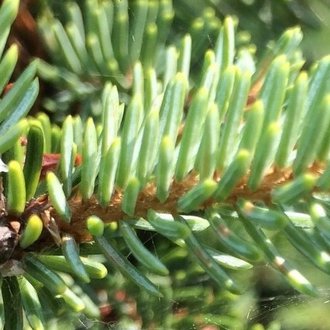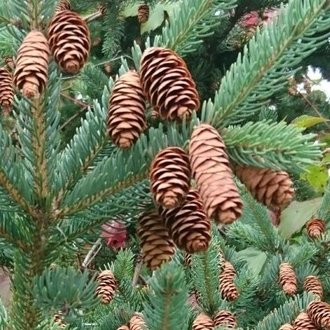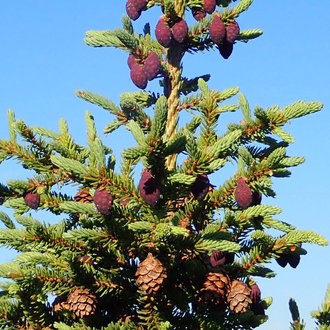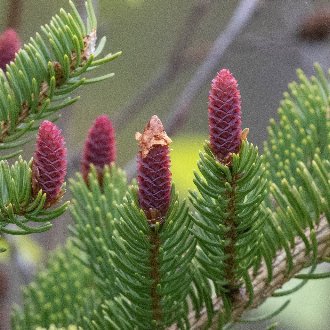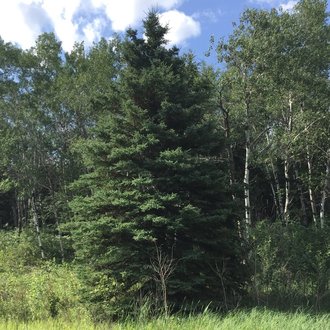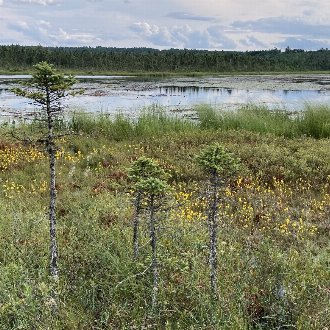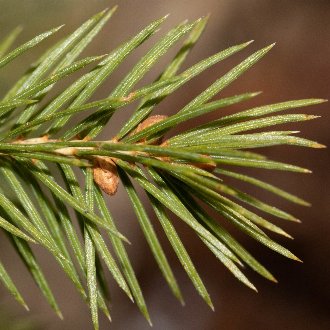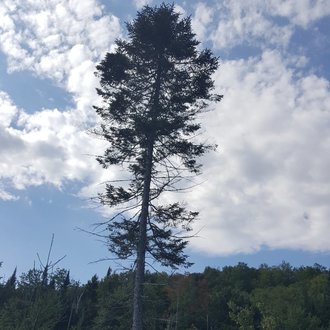White Spruce vs Black Spruce
These two species are often confused as their ranges overlap and both have bluish foliage. They can be relatively easily distinguished by cones, as well as by characteristics of twigs, needles, and buds, and major differences in growth habit and habitat. White spruce occupies richer habitats, with deep, well-drained soils, whereas black spruce is found on poorly drained and/or thin soils. Although it happens rarely, these species can hybridize, so it may not be possible to identify all individuals.
White Spruce (Picea glauca) | Black Spruce (Picea mariana) |
A conifer native to the northernmost reaches of North America; often found on richer sites than black spruce. | A conifer with a northerly distribution, native to North America; found on acidic soils, often on poorly-drained sites, often with stunted growth. |
Twigs hairless or nearly so. Twig color averages slightly more pinkish in color. Photo © Ben Armstrong, CC BY 4.0. | Twigs are hairy. Twig color averages less pinkish, more yellowish. Photo © Derek, CC BY 4.0. |
Larger cones. Cones dropped after they mature; no cones retained by the time new cones are growing. Photo © Shawn Treelife, Public Domain. | Smaller cones. Retains some cones for many years; old cones often present while tree is growing new cones. Photo © Rob Foster, CC BY 4.0. |
Pollen cones much larger (much larger than needles), more cylindrical, and usually pointed upwards. Photo © David McCorquodale, CC BY 4.0. | Pollen cones much smaller (often shorter than even the needles), rounder, and pointing different directions, often horizontally or even downward. Photo © Ben Armstrong, CC BY 4.0. |
Limited to sites with better drainage, and more likely on richer sites with deeper, more fertile soils. Photo © Mary Krieger, CC BY 4.0. | Can survive on harsh sites, including poorly-drained sites such as bogs, as well as sites with thin soil. Photo © er-birds, CC BY 4.0. |
Needles average slightly longer, usually 1.5-2cm, rarely to 0.8cm or 2.5cm. Buds lighter-colored, more orangeish. Photo © David McCorquodale, CC BY 4.0. | Needles average slightly shorter, usually 0.6-1.5cm, rarely to 2cm. Buds darker, more brownish. Photo © Alexis Godin, CC BY 4.0. |
Trees have a lush, full look, often retaining foliage on lower branches, and a pyramidal shape well into maturity. Broader spread, especially towards the base. Photo © Mary Krieger, CC BY 4.0. | Mature trees have a sparse, top-heavy growth habit, losing most lower branches and having very little foliage except at the top. Narrower spread, and live branches under the crown are often narrower than the crown. Photo © Charlie Hohn, CC BY 4.0. |
References & External Resources
These short lists show only links helpful for ID. For a complete list of references and resources also covering other aspects of ecology, visit the links section of the full article on each plant, which is the first entry here.




